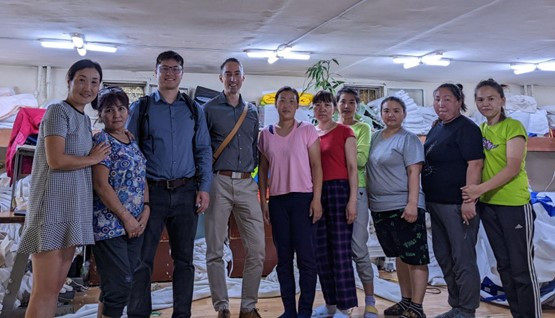“Better insulated gers are cost saving in the longer term and contribute to reducing air pollution” says G. Batchimeg who runs a small sewing SME.
Published: Oct 20, 2022 Reading time: 4 minutes Share: Share an article
Clanks and clatters cut through the noise of the street outside. Urgent voices strain to be heard over the hum of sewing machines from a narrow workshop doorway. Upon entering, it is clear that this small producer can barely keep pace with the volume of orders pouring in. Storerooms overflow with materials, canvas and cloth stretch across the floor, meter by meter everything is measured and cut in preparation for the team to begin their work. The owner, Batchimeg, is totally at ease in this bustling environment. She is relatively indistinguishable from the rest of her workers as she bends to cut fabric and stitches pieces together. This is a physically demanding job that requires everyone to work as a unit to create the massive canvas coverings for Mongolia's favorite dwelling, the ger.
Batchimeg’s factory of 26 employees has grown steadily from its humble beginnings. She has been around gers (the traditional Mongolian nomadic home) and ger production since she was a child.
“I remember carrying rolls of fabric and sewing ger sections since I was young. I worked and helped my family and then started this business about 20 years ago,”
She is proud to have guided her small family business to its current headcount of over two dozen employees; a roster that includes two individuals with disabilities, and three members currently living in Cooking, Heating, Insulation Package Project (CHIP) gers. She states how important it is to use your own products to demonstrate how much you believe in them.
“Personally, I think of it as an honor to help reduce pollution and improve health. When I used to live in the ger district my son had gotten very sick. I think it was from the wide temperature fluctuations and poor air quality,” said Batchimeg.
“When my company does work on this project it makes me happy to know that it is improving the health of the people who live there.”
She also stated that even in this busy condition they are ready to take on new orders. There is a new warehouse and workshop space outside of town large enough to accommodate even a massive order surge. Currently, approximately 5-7 percent of the annual orders are for CHIP gers coverings.
“We can do more orders and scale to meet demand. [However], it will only continue to change the way that families are able to live in their gers and be healthy [additionally], the more the project grows the more jobs it creates. Our staff have good jobs and can bring home money for their families,” Batchimeg continued.
This type of industry isn’t without its challenges. The largest challenge has originated outside of Batchimeg’s company. Their primary obstacle is source materials and their supply chain. Prior to the pandemic, it was roughly one week to place and receive a materials order. Now it is upwards of 45 days to receive shipments. Along with the massive delay in materials has come a substantial increase in transportation costs.
“Transportation costs have risen to over five times what they used to be. This makes our prices continue to increase and cause instability in price which is difficult for customers,” Batchimeg explains.
These factors along with higher quality materials can make the cost prohibitive for many families, which are accustomed to a certain cost for a ger.
Batchimeg educates families about not only the health benefits received from living in CHIP gers, but also the long-term cost savings of having a better insulated home. It pays off in the long run, but it does take time.
There are solutions that can work for everyone. As production increases so can economies of scale. This positively affects the materials and labor needed to build each unit, thus driving down the price of each CHIP ger. Continued funding and support to build demand and show success in the ger districts is crucial to driving future consumption. Batchimeg wanted our team to know that it is not just about betting the environment, it is about the health of those living in the ger districts, the jobs created in each of the CHIP producer factories, and the long-term cost savings for each family.
“I am very happy to be a part of this project and I hope it will continue to grow,” Batchimeg concluded.



